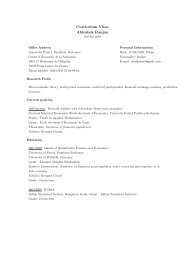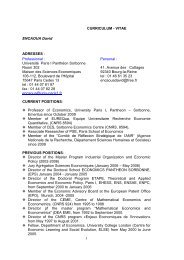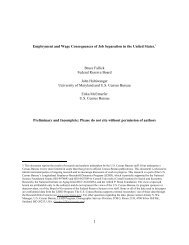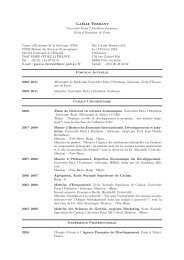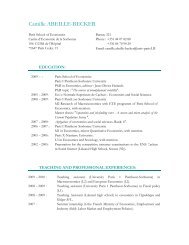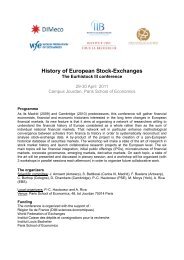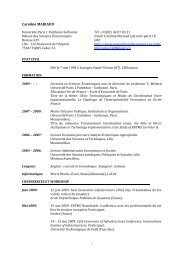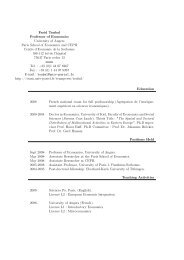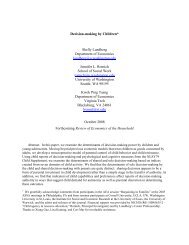info document - Paris School of Economics
info document - Paris School of Economics
info document - Paris School of Economics
You also want an ePaper? Increase the reach of your titles
YUMPU automatically turns print PDFs into web optimized ePapers that Google loves.
AR(1) process and ξ j s,t are i.i.d. conditional on all individual characteristics (including sand A j ). This specification is similar to the econometric processes for wages commonly usedin the literature. 11 The key assumption we make is that the variances <strong>of</strong> these idiosyncraticshocks have been stationary during the period under study. Under this assumption, andletting var (·) denote the cross-sectional variance <strong>of</strong> a variable, we have:var ( ) (log ˜w j s,t = var log wjs,t)+ σ2υ + σξ.2where σ 2 υ denotes the cross-sectional variance <strong>of</strong> the AR(1) process across all age and abilitygroups. Two points are easily noted from this expression. First, the level <strong>of</strong> the variance<strong>of</strong> wages in the model needs to be adjusted by ( σ 2 υ + σ 2 ξ)before it can be compared to thedata. Second, the change over time in the variance <strong>of</strong> observed wages will mirror that inthe systematic component (∆var ( ˜w i s,t)= ∆var(wis,t)) which allows a direct comparison <strong>of</strong>the trend in the model variances to its empirical counterpart.Similarly, the implications <strong>of</strong> the specification in (15) for the first moment <strong>of</strong> wages canalso be seen easily: the average <strong>of</strong> observed log wages equals that <strong>of</strong> the systematic component,E ( log ˜w j s,t|I ) = E ( log w j s,t|I ) , where I denotes a set <strong>of</strong> individuals—for example,those in the same age or education group. Therefore, both the level <strong>of</strong>, and the change in,the first moments <strong>of</strong> log wages in the model can be directly compared to the data.4.1.1 Calibrating Model-Specific ParametersLegal minimum wage.Distributions <strong>of</strong> Ability and Raw Labor. Learning ability, A j , is assumed to be uniformlydistributed in the population with the same parameters for every country. As for thecalibration <strong>of</strong> individuals’ raw labor endowment, note that the present model is interpretedas applying to human capital accumulation after secondary school. But then, assuming thatindividuals start out with the same human capital level—may be too restrictive because itseems likely that different individuals would have accumulated different amounts <strong>of</strong> humancapital by the time they make the college enrollment decision. A simple way to model thisheterogeneity is by assuming that the amount <strong>of</strong> raw labor, l, has a non-degenerate distributionin the population. We also assume l to have a uniform distribution that is the same11 One caveat <strong>of</strong> this specification should be noted. Because the idiosyncratic shocks introduced here aremultiplicative with w j s,t, it can be shown that if individuals take the existence <strong>of</strong> these shocks into accountwhen making their investment decision, this would lead to a different optimal choice than the one thatgenerated w j s,t. Although it is possible to modify the human capital problem and solve it in the presence <strong>of</strong>these idiosyncratic shocks, such an extension comes at considerable computational cost, so we do not tacklethis potential complication here.25



